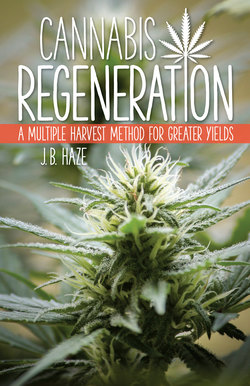Читать книгу Cannabis Regeneration - J.B. Haze - Страница 22
На сайте Литреса книга снята с продажи.
ОглавлениеCHAPTER THREE
INCREASED YIELD
The MRS has transcended both growing from seed and cloning to become my preferred day-to-day method of cultivation. Nowadays I find myself treating a plant grown from seed as a precursor for an intended regeneration.
My prior decades of sporadic cultivation were spent with traditional techniques, both indoor and outdoor; seeds, clones, indica, sativa, wet climates and dry. And, as any grower who has worked with plants over stretches of time will tell you, sometimes the girls will do strange things.1 Odd stuff—quirks like having a simple topping result in five or six new shoots, or having a plant suddenly turn purple.
One peculiarity teased me over the years, eventually becoming the catalyst for The MRS. I had observed that certain plants, even those harvested right down to a stump, would, just sometimes, spontaneously burst into new growth. While this occurrence was occasional, it was always surprising: Life springing from a mere nub and a few straggling calyxes. I began considering this new growth as a possibility for systematic adaption, and thinking How can this amazing will to grow be utilized? I soon started to look into how best to ensure the magical regeneration every time, and how to maximize the plant’s zest for rapid proliferation.
I now always consider the initial grow of a plant (from seed) as a precursor to regeneration. During this initial grow, the aim is fine-tuning such things as nutrient intake (is the plant receiving enough, too much, is she wilting or browning at the tips?), disease and pest control (have pests been detected and treated, are there signs of disease?), deficiencies (have nitrogen, manganese and other irregularities been noted and addressed?) and so on. These, and any other possible problems along the way, create stress. When the plant has to deal with such headaches, she can’t excel.
3.1 A just harvested stump, ready to be rescued and regenerated.
Identifying and then avoiding the pests, disease, deficiencies, watering problems and the like, encountered the first time around, creates a stress-reduced second grow. A close relationship between plant and grower, with the plant’s needs being tended to precisely and with great passion, will assure a bountiful harvest.
We can see the rapid growth of a regenerated plant for ourselves—just look at photographs 3.1 and 3.2. The first photograph shows the potted remains of a just harvested plant. It’s nothing more than a nub of stump with a couple of scraggly buds. This stump was saved, regenerated and then vegetated over six weeks, quickly reaching the mad flurry of healthy growth shown in the second photograph. Gob smacking; faster than both seed and clone, in fact. What’s equally impressive, I think, is that she was grown with a single 36-watt light and two hours of sun, twice a week, during watering/feeding sessions.
3.2 The same stump, five weeks later, full of vigorous growth and potential budding sites.
Such vigorous growth is a hallmark of The MRS and is especially beneficial for the personal grower with only a plant or two in the grow room. Under such circumstances, sufficient yield is about having enough high quality head-stash (or medicine) until the next plant is ready. To lay in a solid supply cost-effectively, with a single light and one pot is advantageous and requires special attention to plant selection and vegetative technique. We must maximize potential, squeezing as much goodness from the plant as we can. We must push her towards the built-in, genetically encoded limit for the production of flowers, resin, potency and aroma. Called the ceiling of potential, this is the very maximum a plant can deliver. Once the ceiling is reached, nothing will produce further yield or quality.
Typically, a plant will only approach its threshold if grown outdoors, in the ultimate conditions, where, depending on its heritage, it may max out as a huge 15- to 20-foot giant. The same plant, grown indoors, will be an eighth of this size (or way, way less), thus never approaching its maximum yield. To comprehend this is to understand how, when growing indoors, there’s always plenty of extra yield to be squeezed from the plant. You are always reaching for the elusive ceiling of potential.
3.3 Good quality LED grow light illuminates a pot abundant in bud.
The regenerative secret to maximizing yield indoors is dependent upon training: Creating a plant/light interface designed to pull maximum yield from a single, and cost-effective, light source. Photograph 3.3.
